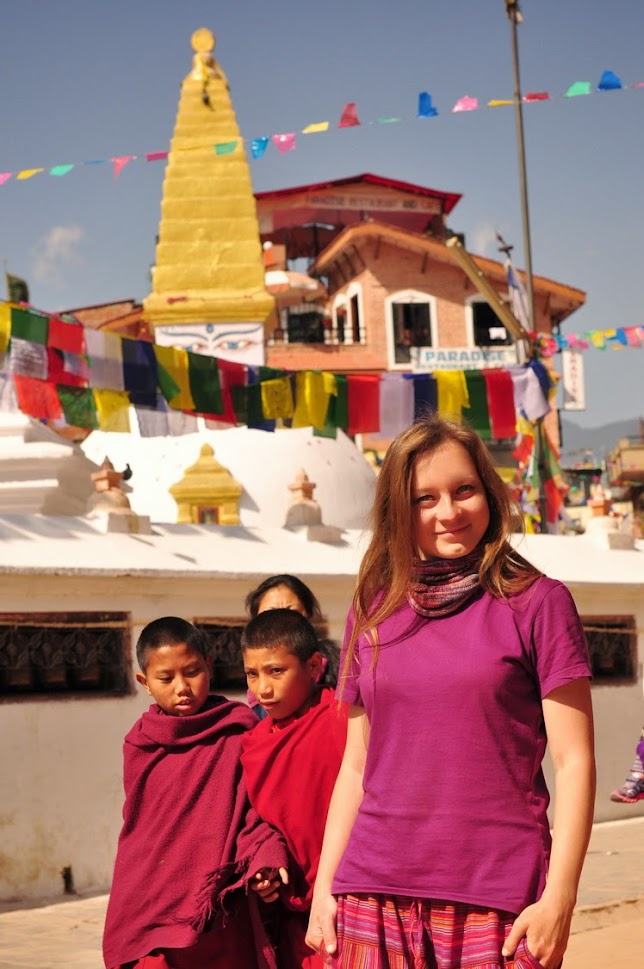Nepal. Boudhanath
In the evening, we arrived at the Buddhist temple center - Boudhanath, from Patan. Settling into one of the alleys in the district, we went to dine at a restaurant with a beautiful view of the stupa, which was illuminated by candles by that time. The next day, we planned to dedicate to serenity and spend it near the stupa...
Boudhanath is considered the main center of Tibetan Buddhism in Nepal. The stupa was built in the 6th century and is often mentioned in historical documents. Boudhanath served as a path from Tibet to India, where many pilgrims stopped.
The stupa represents a spatial mandala (circle, disk), where the base symbolizes the earth, the hemispherical dome symbolizes water, the spire with 13 steps (representing the steps to Nirvana) symbolizes fire, the umbrella symbolizes air, and the pinnacle on top symbolizes the sky...
You can circumambulate the stupa on the first terrace, either entering inside or from the outside of the fence, where prayer wheels are located. Around the stupa, in a circle, there are hotels with rooftop restaurants and souvenir shops...
The atmosphere promotes serene and peaceful moments. This mood starts early in the morning. You wake up to the morning chants of the monks, step out to the stupa, circumambulate it clockwise along with colorful pilgrims, spin prayer wheels, enter inside the stupa, walk around its terraces, breathe the unique air scented with spicy herbs burning before the main shrine. Everything is vivid and positive, enhanced by the colorful prayer flags inscribed with various Sanskrit mantras - syllables of Enlightenment...


Postcards also vividly capture the spiritual essence...
Offerings usually consist of flowers symbolizing both beauty and impermanence, candles symbolizing the radiance of Enlightenment, and incense filling the air, much like the Truth realized by Buddha fills the Universe...
To understand what Buddhists pray for, it's crucial to realize that Buddhism does not have gods. When Buddhists bow before an image of Buddha or a bodhisattva, offering flowers, candles, and incense, they honor Buddha as an enlightened being, not worship him as a god. For instance, in the Theravada teachings (the oldest school of Buddhism), it's openly stated that prayers cannot change the external world: "Nature is impartial; it cannot be influenced by prayers. It does not yield to anyone's requests." Prayers simply have no recipient: "Buddhism teaches that no higher being directs human affairs and fate." The term "prayer" continues to be used in Theravada texts, but what is called a prayer cannot influence either nature (due to its impartiality) or a higher being (since it is presumed absent). The above-mentioned "prayer" is only part of the meditation process and can only affect the mind of the person uttering it: "The human mind responds to prayers launched into space." Therefore, when launching into space a prayer, space in this aspect is our unknown consciousness... However, it is possible that for some worshipers it is easier to believe in the Buddha-God and ask him for something, only this will already be another religion.... And in the original, prayer rituals are part of meditation, to achieve "God" in your own mind...
We preferred to relax and replenish our supplies of calories in rooftop restaurants, never separating for a moment from the stupa we loved...
For all the time we spent in Boudhanath, we were able to wind a huge amount around the stupa and see the most colorful representatives of the local population, which added a special ambience...
As I already described above - the smell of spicy herbs hung in the air; so, the main source of this calming spirit was a peculiar golden kettle, in which the herbs did not stop burning...
We spent a wonderful time in Boudhanath, and not a full 2 days, we had enough to saturate this atmosphere. Anyway, spiritual development is hidden not in places of pilgrimage, but much further - inside each of us, where it is not so easy to get into...








































Comments
Post a Comment